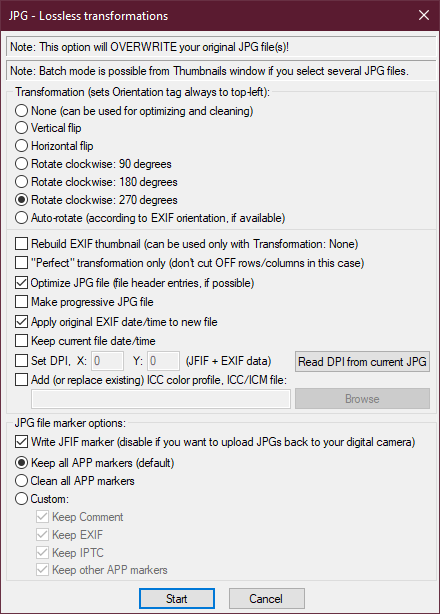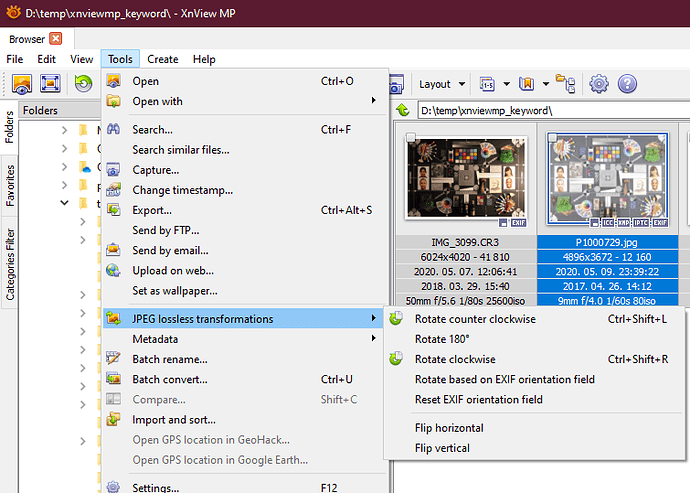There are several proposals for adding a flip function. According to DxO, the request has been put in the backlog: Flip Image
I found a flip function in the Microsoft Photos app 10 minutes after posting here.
Will using that app as a last operation after exporting from PL3 degrade the quality of the image?
I must be missing something, surely you just need to mount the negative the other way round?
stuck
Mostly a 90 degrees rotation/flipping is just rearranging the pixels. When writing to disk as a jpg the image will be compressed again, when you use jpg. When you used tiff no problem.
George
I would rather suggest you to use IrfranView or XnViewMP as they surely have JPG lossless operations (both rotate and flip), which means no recompression and quality change in the file. This functions are in a separate menu.
As stated by George, it is not relevant for TIFF files.
But that would mean photographing through the film with the emulsion on the back (facing the camera), which can give a softer image.
My suggestion for a workaround would be to edit everything in the reversed sense, then export to a TIFF and reverse that outside of DxO. It’s not great but it’s possible. I am used to seeing all my images reversed on the ground glass screen of a large format film camera (5" x 4") so it’s a little easier to imagine the correct layout/cropping.
The problem then becomes one of having to store a TIFF as well as the original RAW. But you would have to do that if you were using Photoshop.
I admit that I never asked myself the question for a negative, but it is nevertheless the case when we scan a slide?
I admit that I never asked myself the question for a negative, but it is nevertheless the case when we scan a slide?
All film has the emulsion on the lens side, which means that you need to scan/photograph it from the emulsion side, which then appears reversed.
that would mean photographing through the film with the emulsion on the back (facing the camera), which can give a softer image.
Ah yes, I was missing something, thank you.
it is nevertheless the case when we scan a slide
I suppose so, I hadn’t thought of that even having read Joanna’s post. Next time I scan a slide I’ll experiment. However, as far as I know the instructions for my Nikon Coolscan VED are to insert the slide as you would view it, i.e. through the film / with the emulsion on the back. Given that I’d guess the device is optimised for that orientation.
stuck
After verification, I was indeed mistaken: with a scanner like the Nikon VED (which I also have), it is necessary to place the emulsion on the low side, ie in the direction of the scanning device. On a flatbed scanner (type Epson V500 / 700), it is the opposite.
Currently, I have abandoned (temporarily?) The VED scanner due to a change of PC: installation problems with the latest versions of Windows 10.
Now I “scan” with a macro lens: the advantage is that it is much faster and just as qualitative with the current sensor sizes. And above all it allows to have raw files to use directly in PhotoLab. The downside is that you cannot take advantage of the ICE to remove dust automatically.
I am not convinced that the emulsion / film orientation has a real importance for the sharpness of the image, at least with films not too old. I do not see a difference according to the direction with my macro lens device.
I think that the obligation to place the emulsion at the bottom with a VED is due to the internal Focus system which requires the emulsion side, and also the hardware ICE which can only work on this side. The V500 / 700 scanners only have a software ICE, and therefore do not have this obligation.
It looks like there are several image flipping options available online, but I can’t tell if they’re lossless.
I would rather suggest you to use IrfranView or XnViewMP as they surely have JPG lossless operations (both rotate and flip)
Looked at both sites, lossless rotate & crop, but no flip.
Currently, I have abandoned (temporarily?) The VED scanner due to a change of PC: installation problems with the latest versions of Windows 10
I can help you with that:
- read this: http://axelriet.blogspot.com/2009/10/nikon-ls-40-ls-50-ls-5000-scanners-on.html
- but get the last version of Nikon Scan (4.0.3) here: https://www.nikonimgsupport.com/ni/NI_article?articleno=000002646&configured=1&lang=en_US because the link actually in the blog post doesn’t work.
- carefully follow the instructions in the blog post.
It works fine on my Win 10 machine, currently on Win 10 v1903.
stuck
Thank you.
It’s the same install I used previously, only the .inf file looks a little different. I will try again.
It is possible with both software.
You can also download ZIP only versions from both which you don’t need to install, only unzip to a folder and start.
IrfanView Download - ZIP only also possible
IrfanView Plugins
JPG_TRANSFORM - (version 4.54 ): allows IrfanView to support lossless JPG operations (rotation/crop/cleaning, EXIF date editing, EXIF thumb update)
Irfan View Plugin - has flip, “Options - JPG lossless rotation”
XnView MP download
XnView MP
Thanks for going through the effort to show me this Zoltan, I only looked at the feature list on the website homepage which listed rotate but not flip.
I’ll download this and try it.
It’s the same install I used previously, only the .inf file looks a little different. I will try again.
Yes, do! Especially as your post reminds me that I think I had to re-install after my machine was updated from Win 10 1809 to 1903.
stuck
There are quite a few requests for flipping, which can also be set by editing the “orientation” EXIF tag by those who dare editing the raw file. It takes some experimenting to get things right.
I find this page to show orientation in a fairly comprehensive manner.
On a Mac, these commands help manage the orientation tag of a single image file
-
Show orientation tag: exiftool -Orientation -n /…path…/filename.ext
-
Set orientation tag: exiftool -Orientation=2 -n /…path…/filename.ext
-
Note: If the first command shows the tag to be 1, the second command sets the tag
so that orientation enabled apps will show the image horizontally flipped. -
The “-n” switch reports the value of the orientation tag numerically, without it, you can
get something like “Flip horizontally and rotate 270° CW”.
Caveat: DxO PhotoLab still can’t flip an image, even if you set the rotation tag accordingly.
This is the second time (after here: Set GPS-Locations to image while merge with a track)
that a Button to start exiftool with editable parameters out of PhotoLab would be very nice.
parameters could be
exiftool -Orientation=2 [CURRENT_FILE]/[CURRENT_DIR]/…
Zioltan,
Downloaded Irfanview, did exactly what I needed. Thanks for the direction.
Rex

